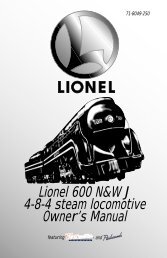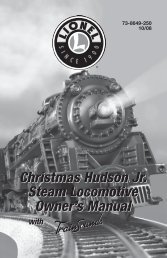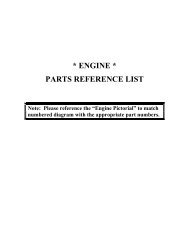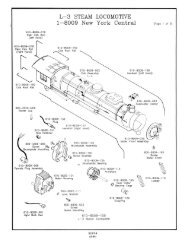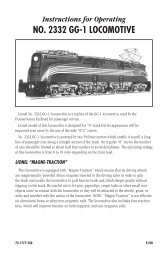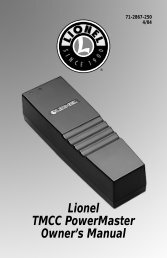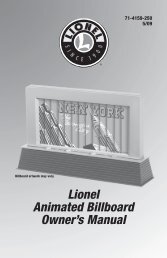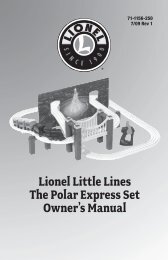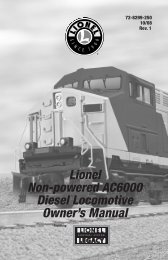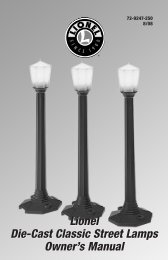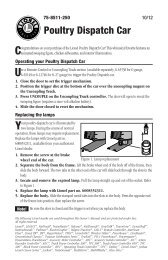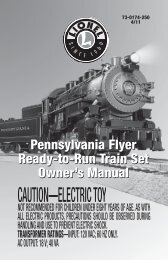Lionel LionMaster SD-80/90 Diesel Locomotive Owner's Manual
Lionel LionMaster SD-80/90 Diesel Locomotive Owner's Manual
Lionel LionMaster SD-80/90 Diesel Locomotive Owner's Manual
You also want an ePaper? Increase the reach of your titles
YUMPU automatically turns print PDFs into web optimized ePapers that Google loves.
72-8201-250<br />
6/03<br />
<strong>Lionel</strong><br />
<strong>LionMaster</strong> <strong>SD</strong>-<strong>80</strong>/<strong>90</strong><br />
<strong>Diesel</strong> <strong>Locomotive</strong><br />
Owner’s <strong>Manual</strong><br />
featuring<br />
®<br />
and<br />
SYSTEM
Congratulations!<br />
You purchased a tough, durable locomotive—the<br />
TrainMaster Command<br />
Control and Odyssey System-equipped<br />
<strong>LionMaster</strong> <strong>SD</strong>-<strong>80</strong>/<strong>90</strong> diesel locomotive built<br />
by <strong>Lionel</strong>. From the crisp detail and expert<br />
decoration on the outside to the brute power<br />
under the hood, the <strong>LionMaster</strong> <strong>SD</strong>-<strong>80</strong>/<strong>90</strong> is<br />
ready for duty on your model railroad.<br />
Experience the superiority of today’s <strong>Lionel</strong>.<br />
Features of this locomotive<br />
•Two powerful maintenance-free motors<br />
with momentum flywheels<br />
•TrainMaster Command Control<br />
equipped<br />
• RailSounds sound system with<br />
CrewTalk communication and<br />
TowerCom announcements (in<br />
Command)<br />
• Odyssey System for speed control<br />
• Directional lighting including front and<br />
rear headlights and marker lights<br />
•Two ElectroCouplers (in Command)<br />
• Fan-driven smoke unit<br />
• Lighted cab interior<br />
•Tire-Traction<br />
The following <strong>Lionel</strong> marks may be used throughout this instruction manual and are protected under<br />
law. All rights reserved.<br />
<strong>Lionel</strong> ® , TrainMaster ® , Odyssey ® , RailSounds ® , CrewTalk , TowerCom , DynaChuff ,<br />
StationSounds , Pullmor ® , ElectroCoupler , Magne-Traction ® , CAB-1 Remote Controller ® ,<br />
PowerMaster ® , <strong>Lionel</strong> ZW ® , ZW ® , PowerHouse ® , TMCC ® , <strong>Lionel</strong>ville <br />
The name FasTrack ® is used with permission from Pitsco, Inc.<br />
2
Table of contents<br />
Transformer operations<br />
Running your locomotive with a <strong>Lionel</strong> transformer 4<br />
Locking your locomotive into a single operational state 5<br />
Using your locomotive’s ElectroCouplers in the non-Command environment 5<br />
Installing a <strong>Lionel</strong> Sound Activation Button 6<br />
RailSounds sound system operations<br />
Your locomotive’s RailSounds sound system—the basics 7<br />
Experiencing the range of your locomotive’s RailSounds sound system 8<br />
Notes on the RailSounds sound system 8<br />
Odyssey System operations<br />
The Odyssey System 9<br />
Odyssey System conventional (transformer) operation 9<br />
Odyssey System Command operation 9<br />
TrainMaster Command operations<br />
The Command Control environment 10<br />
Running your locomotive in the TrainMaster Command environment 11<br />
CAB-1 Remote Controller commands for your locomotive 11<br />
CAB-1 Remote Controller numeric keypad commands for your locomotive 12<br />
Tuning your locomotive’s performance 13<br />
Assigning your locomotive a new ID# 14<br />
Reprogramming the Command reverse unit to restore features 15<br />
Building a lash-up 16<br />
Maintaining and servicing your locomotive<br />
Adding fluid to your locomotive’s smoke generator 17<br />
Lubricating your locomotive 18<br />
Replacing your locomotive’s LEDs 19<br />
Replacing the traction tires 19<br />
Limited Warranty/<strong>Lionel</strong> Service 20<br />
3
Transformer operations<br />
Running your locomotive with a <strong>Lionel</strong> transformer<br />
1<br />
Place your locomotive on <strong>Lionel</strong> or <strong>Lionel</strong>-compatible<br />
O-31 or larger track.<br />
2<br />
Caution!<br />
Note!<br />
Power up your locomotive with your transformer.<br />
Your locomotive is designed to operate on 8-18 volts alternating<br />
current. Virtually all <strong>Lionel</strong> and <strong>Lionel</strong>-compatible alternating-current<br />
transformers are suitable.<br />
Do not power your locomotive with direct current (DC). Damage to<br />
sensitive electronic components may occur.<br />
When you first power up your track, the locomotive will wait<br />
between three and eight seconds as it “listens” for digital language from the<br />
TrainMaster Command Base (available separately). When it has determined that it’s<br />
on a conventional (non-Command) railroad, the locomotive’s headlight will<br />
illuminate and RailSounds will fire up. At this point, the locomotive is in neutral.<br />
(This occurs when placing the locomotive on your railroad for the first time.<br />
Thereafter, it will start in forward following every five-second power interruption.)<br />
3<br />
Move ‘em out!<br />
Get your locomotive moving. Press the DIRECTION button on your <strong>Lionel</strong><br />
transformer. This sequences the Command reverse unit to the next operating state.<br />
Adjust track voltage until your locomotive moves at your desired speed. To<br />
increase speed, increase track voltage. To decrease speed, reduce voltage. To stop the<br />
locomotive, turn-off track power.<br />
4
Transformer operations<br />
Locking your locomotive into a single operational state<br />
To select a single operational state<br />
for your <strong>Lionel</strong> locomotive (for<br />
example, forward only), you can<br />
deactivate the Command reverse unit’s<br />
sequencing function with the<br />
Command reverse unit switch.<br />
Get your locomotive moving in<br />
the desired direction, then slow it<br />
down without stopping. Set the<br />
Command reverse unit switch to<br />
PGM. Refer to Figure 1 for the<br />
location of the switch. The<br />
locomotive is now “locked” into<br />
your chosen direction.<br />
When you no longer want single-direction<br />
operation, just slide the Command reverse<br />
unit switch back to RUN.<br />
Command reverse<br />
unit switch<br />
RUN<br />
PGM<br />
SMK<br />
NO SMK<br />
Smoke Unit Switch<br />
(see page 17 for details)<br />
Figure 1. Switch location<br />
Note!<br />
RailSounds<br />
sound system<br />
switch<br />
SND<br />
NO SND<br />
Your locomotive’s reverse unit<br />
will “reset” to forward after any<br />
power interruption lasting five<br />
seconds or longer, regardless of<br />
the original locked-out direction.<br />
Using your locomotive’s ElectroCouplers in the non-Command<br />
environment<br />
To uncouple rolling stock from your<br />
locomotive’s ElectroCouplers in the non-<br />
Command environment, you must rely on a<br />
piece of rolling stock equipped with <strong>Lionel</strong><br />
Magnetic coupler on the rolling stock<br />
coupled to your locomotive<br />
Remote-Control<br />
Track section<br />
Figure 2. Trigger disc operation<br />
Note!<br />
magnetic couplers coupled directly to your<br />
locomotive’s ElectroCouplers. The magnetic<br />
coupler on the rolling stock will then react<br />
to the magnetic field generated by a <strong>Lionel</strong><br />
Remote-Control Track section (available<br />
separately, 6-65530 for O gauge; 6-65149 or<br />
6-12746 for O-27 gauge; and 6-12020 for<br />
FasTrack layouts). Place your rolling stock’s<br />
coupler “trigger disc” over the central coil<br />
of a Remote-Control Track section and press<br />
UNCOUPLE on the controller. As illustrated<br />
in Figure 2, the magnetic field pulls the disc<br />
downward, and the coupler opens.<br />
See page 11 to learn how to release the<br />
couplers in the Command Control<br />
environment.<br />
Your locomotive’s ElectroCouplers will NOT open manually or by using a<br />
Remote-Control Track section.<br />
5
Transformer operations<br />
Installing a <strong>Lionel</strong> Sound Activation Button<br />
To activate the bell and whistle sounds<br />
when operating your locomotive with<br />
conventional transformers, you may need to<br />
install <strong>Lionel</strong> no. 610-5<strong>90</strong>6-001 Sound<br />
Activation Buttons (available separately) if<br />
your transformer is not equipped to activate<br />
For AC transformers lacking a bell button<br />
these features. Connect the button(s) as<br />
shown below.<br />
Note! All track power must feed through<br />
the Sound Activation Buttons. Do<br />
not bypass the buttons.<br />
Black wire<br />
1 2<br />
Red wire<br />
Existing wire<br />
Common/Ground/U<br />
POWER<br />
SUPPLY<br />
Power/A<br />
<strong>Lionel</strong> no. 610-5<strong>90</strong>6-001<br />
Sound Activation Button for<br />
activating the bell<br />
For AC transformers lacking bell and horn/whistle buttons<br />
Red wire<br />
Existing wire<br />
Common/Ground/U<br />
<strong>Lionel</strong> no. 610-5<strong>90</strong>6-001<br />
Sound Activation Button<br />
for activating the<br />
horn<br />
Black wire<br />
Wire<br />
nut<br />
Red wire<br />
POWER<br />
SUPPLY<br />
Power/A<br />
<strong>Lionel</strong> no. 610-5<strong>90</strong>6-001<br />
Sound Activation Button for<br />
activating the bell<br />
Note!<br />
The no. 610-5<strong>90</strong>6-001 button works with any <strong>Lionel</strong> AC transformer except<br />
no. 6-46<strong>90</strong> Type MW. Transformers made by other manufacturers may not be<br />
compatible with the RailSounds sound system.<br />
6
RailSounds sound system operations<br />
Your locomotive’s RailSounds sound system—the basics<br />
The <strong>Lionel</strong> RailSounds sound system is<br />
the most realistic model railroad sound<br />
system in the world. Your locomotive<br />
features digital samples from real-life diesel<br />
locomotives for the ultimate in realism.<br />
You may choose to install a nine-volt<br />
alkaline battery in your locomotive. This<br />
ensures interruption-free operation of the<br />
RailSounds sound system. The battery<br />
harness is located inside the body. Carefully<br />
unsnap the radiator hatch to access the<br />
battery harness. As illustrated in Figure 3,<br />
snap the battery harness onto the battery,<br />
then slide the battery into the holder and<br />
replace the radiator hatch.<br />
When you first apply track power, the<br />
locomotive’s sound system produces sounds<br />
of the locomotive at rest. As the locomotive<br />
moves, the RPMs increase with the<br />
locomotive’s speed.<br />
To silence the diesel roar (the horn and bell<br />
remain unaffected), slide the RailSounds<br />
sound system switch on the underside of the<br />
locomotive to NO SND (refer to Figure 1 on<br />
page 5) before powering up the locomotive.<br />
Radiator hatch<br />
Battery harness<br />
Volume control knob<br />
Battery holder<br />
Figure 3. Battery installation and volume control knob location<br />
Note!<br />
Note!<br />
Note!<br />
Note!<br />
Please remove the protective cover from the battery harness.<br />
Although the RailSounds sound system is powered by track voltage, the battery<br />
is required for uninterrupted operation and shutdown sequences. Use only<br />
alkaline batteries.<br />
Discontinue locomotive power for ten seconds before changing the RailSounds<br />
sound system switch position.<br />
If the RailSounds sound system “drops out” during track power interruptions<br />
(for example, during a direction change), replace the battery.<br />
7
RailSounds sound system operations<br />
Experiencing the range of your locomotive’s RailSounds system<br />
With the RailSounds sound system, you<br />
experience the sounds of real<br />
railroading like never before. Simply put,<br />
it’s the most sophisticated, authentic model<br />
railroad sound system in the world.<br />
• Four diesel-roar levels. Your<br />
locomotive’s speed determines the level<br />
of diesel RPM roar. If you prefer, you<br />
may set the level to idle, half throttle,<br />
three quarters, or full-speed output.<br />
• MultiHorn. A different horn sound at<br />
different speeds—a RailSounds sound<br />
system exclusive.<br />
• Mechanical bell. Press BELL on your<br />
CAB-1 Remote Control or transformer to<br />
begin the effect, again to discontinue.<br />
Notes on the RailSounds sound system<br />
• Reverse unit reset sound. Power<br />
down your track, wait for three to five<br />
seconds, and listen for the air-release<br />
sound—that’s the locomotive telling you<br />
that its <strong>Lionel</strong> Command reverse unit has<br />
just reset to forward operation.<br />
• Shutdown sequence. No other model<br />
railroad sound system shuts down like<br />
the RailSounds sound system. Turn off<br />
track power, and after the air-release<br />
reset sound, you have two seconds to<br />
restart your locomotive. If you’re done<br />
with operations, the RailSounds sound<br />
system will commence with a realistic<br />
diesel shutdown sequence about two<br />
seconds after the air-release reset occurs.<br />
(Battery installation required.)<br />
• Turn the volume knob clockwise or<br />
counter-clockwise in the location shown<br />
in Figure 3 on page 7 to adjust sound<br />
output.<br />
• Listen for incidental locomotive sounds<br />
during RailSounds sound system<br />
operation. They’re automatic and, of<br />
course, authentic.<br />
• The nine-volt alkaline battery you<br />
installed ensures continuous locomotive<br />
diesel sounds.<br />
• Longer track-power interruptions<br />
(including locomotive derailments)<br />
cause the RailSounds sound system to<br />
shut down after about seven seconds.<br />
• For even more authentic RailSounds<br />
sound system effects, operate in the<br />
TrainMaster Command Control<br />
environment. See page 10-13 for more<br />
information.<br />
8
Odyssey System operations<br />
The Odyssey System<br />
The Odyssey System is a “cruise control”<br />
for your engine. Once the speed is set<br />
(see below), your engine will maintain a<br />
constant speed, no matter what loads the<br />
locomotive pulls or what grades you have on<br />
your layout. This digitally-controlled system<br />
also allows for extremely slow movement<br />
that will amaze any “scale” enthusiast.<br />
Odyssey System conventional (transformer) operation<br />
Setting Speed Control<br />
1. Run the engine at the desired speed for approximately five seconds.<br />
2. Press and hold the horn button.<br />
3. While holding the horn button, increase the track voltage by at least three volts (at<br />
least a quarter turn).<br />
4. At this point, speed control is set.<br />
Note!<br />
The speed of the locomotive will increase slightly before returning to the set speed.<br />
Turning Off Speed Control:<br />
1. While the engine is in neutral, turn your controller up to the maximum power (no<br />
more than 19 volts), wait one second, then press and hold the horn button.<br />
2. While holding the horn button, slowly reduce track voltage to one-fourth of full power.<br />
3. Release the horn button.<br />
4. Cycle the engine to forward or reverse. The engine is now out of speed control mode.<br />
Caution!<br />
In conventional operation, the smoke unit and lights are connected directly to<br />
track power. Do not exceed 14-16 volts for extended periods. Doing so will cause<br />
damage to the locomotive.<br />
Odyssey System Command operation<br />
While in the Command Control<br />
environment, the speed control<br />
feature of the Odyssey System is always on.<br />
When turning the throttle, the speed of the<br />
locomotive will respond to each signal from<br />
the Command Base. For example, Address<br />
the locomotive and slowly turn the throttle.<br />
The first flash of the red light on the<br />
Command Base corresponds to the first<br />
speed step. This is the slowest speed of the<br />
locomotive.<br />
9
TrainMaster Command operations<br />
The Command Control environment<br />
TrainMaster Command Control is the<br />
advanced model railroad control system<br />
from <strong>Lionel</strong>. TrainMaster Command Control<br />
gives you the power to operate multiple<br />
Command-equipped locomotives on the<br />
same track, at the same time.<br />
To operate in Command mode, you<br />
need a Command Base (6-12868) and<br />
a CAB-1 Remote Controller (6-12911).<br />
Find them both at your authorized <strong>Lionel</strong><br />
retailer.<br />
1<br />
2<br />
3<br />
Place your locomotive on <strong>Lionel</strong> or<br />
<strong>Lionel</strong>-compatible O-31 or larger track.<br />
• Make sure track power is OFF before placing on the track.<br />
• Make sure your <strong>Lionel</strong> Command Base is plugged-in and its<br />
communications wire is connected to the COMMON post on your <strong>Lionel</strong><br />
transformer or the U terminal on any of your installed PowerMasters.<br />
• Once positioned on the track, increase track voltage to FULL (no more<br />
than 19 volts). On PowerMasters, slide the CMD/CONV switch to CMD.<br />
Address your locomotive using your CAB-1 Remote Controller.<br />
• Press ENG and 1 on the numeric keypad of your CAB-1 Remote Controller.<br />
This command is sent by your CAB-1 Remote Controller to the Command Base,<br />
which then translates your command into digital code. That code is sent around<br />
your railroad’s outside rails in the form of a digital “halo.” All Commandequipped<br />
<strong>Lionel</strong> locomotives listen to this digital communication, but they do<br />
not respond until they hear their individual ID number—in this case, “1.”<br />
• The digital language of TrainMaster Command Control—and not<br />
track power—controls the actions of Command-equipped <strong>Lionel</strong><br />
engines. Track power is simply like gasoline in the tank of your car—it gives<br />
you the power to go places, but it doesn’t tell you where to go or how fast to get<br />
there.<br />
• All Command locomotives come factory-programmed with an ID#<br />
of “1.” To change the ID# of your locomotive, see page 14.<br />
Move ‘em out!<br />
• Throttle up or press any command button on the CAB-1 Remote<br />
Controller. Your locomotive will respond to your every command.<br />
10
TrainMaster Command operations<br />
Running your locomotive in the TrainMaster Command Control<br />
environment<br />
Example Address <strong>Locomotive</strong> #1<br />
Set PowerMaster to CMD or traditional<br />
power supplies to full throttle (no more<br />
than 19 volts)<br />
Press ENG<br />
Press 1 (the ID#)<br />
Throttle up/press any command button<br />
Your Command-equipped locomotive<br />
comes factory-programmed with an<br />
ID# of “1.” To address your locomotive,<br />
set PowerMasters to CMD or set all power<br />
supplies on full (no more than 19 volts).<br />
Press ENG and 1 on your CAB-1 Remote<br />
Controller. Turn the throttle or press any<br />
command button; your locomotive is<br />
ready for Command Control operations.<br />
CAB-1 Remote Controller commands for your locomotive<br />
RailSounds sound system effects in bold italic.<br />
Front coupler releases.<br />
Coupler release<br />
sounds.<br />
Note!<br />
Rear coupler releases.<br />
Coupler release<br />
sounds.<br />
Activates the<br />
numeric keypad.<br />
Air-release<br />
sound.<br />
Press AUX2 to turn<br />
your locomotive’s<br />
headlights on and<br />
off.<br />
Turn the THROTTLE<br />
to the right to<br />
accelerate, left to<br />
decelerate.<br />
Press HALT to shut<br />
down all PowerMaster<br />
electrical output on<br />
your railroad. Stops all<br />
Command-equipped<br />
<strong>Lionel</strong> locomotives in<br />
operation.<br />
Use HALT only in emergency situations.<br />
11<br />
Press WSTL/HRN to<br />
activate the locomotive’s<br />
horn, release it to<br />
discontinue. MultiHorn diesel<br />
horn sound.<br />
Press BELL once to activate<br />
the bell, again to<br />
discontinue. <strong>Diesel</strong><br />
mechanical bell sound.<br />
Press DIRECTION—the<br />
locomotive decelerates to a<br />
complete stop; turn the<br />
throttle up, and the locomotive will<br />
accelerate in the opposite direction.<br />
There is no neutral state. <strong>Diesel</strong><br />
air-release sound.<br />
Press and hold BOOST<br />
for extra power. Release<br />
BOOST and return to the<br />
locomotive’s previous speed.<br />
Press and hold BRAKE<br />
to slow down or stop.<br />
Release BRAKE and<br />
return to the previous speed.<br />
Squealing brake sounds.<br />
Beneath this panel<br />
SET L M H
TrainMaster Command operations<br />
CAB-1 Remote Controller numeric keypad commands for your<br />
locomotive<br />
When you press AUX1 on your CAB-1 Remote Controller, you<br />
turn the numeric keypad into ten command buttons. The<br />
keypad lets you control extra command features (until you press any<br />
top-row button like SW, ACC, RTE, TR, orENG). The CAB-1<br />
Remote Controller keypad overlay included with this locomotive will<br />
help you learn the extra commands specific to ths unit.<br />
RailSounds sound system effects in bold italic.<br />
0<br />
Stops<br />
1<br />
Raises<br />
2<br />
CrewTalk<br />
3<br />
Raises<br />
4<br />
Lowers<br />
5<br />
Activates<br />
and resets the locomotive. Resets<br />
the locomotive’s direction to<br />
FORWARD. Resets the RailSounds<br />
sound system to automatic RPM<br />
operation. Horn blows. RPMs<br />
return to automatic.<br />
the volume of the RailSounds<br />
sound system. Sound volume<br />
increases.<br />
communication is the<br />
sound of unintelligible walkie-talkie<br />
communication.<br />
the RailSounds sound system<br />
RPM’s level. Starts up the RailSounds<br />
sound system. RPMs increase.<br />
Start-up sequence commences.<br />
the volume of the RailSounds<br />
sound system. Sound volume<br />
decreases.<br />
the RailSounds sound system<br />
shutdown sequence. Just like the real<br />
thing, your locomotive’s RPMs must<br />
be at idle for shutdown to occur. Press<br />
6 repeatedly to lower the RPMs until<br />
they won’t descend further. Your<br />
locomotive is now at idle. Press 5 to<br />
initiate the shutdown sequence and<br />
6<br />
Lowers<br />
7<br />
TowerCom<br />
8<br />
Turns<br />
9<br />
Turns<br />
➠<br />
VOLUME<br />
➠<br />
DIESEL<br />
TOWER<br />
COM<br />
CREW<br />
TALK<br />
SHUT<br />
DOWN<br />
SMOKE<br />
OFF ON<br />
ENGINE<br />
RESET<br />
START-UP<br />
➠<br />
RPMS<br />
➠<br />
listen for the CrewTalk sound.<br />
CrewTalk sounds, <strong>Diesel</strong><br />
shutdown commences.<br />
Remember, the horn, bell, and RPM’s<br />
will not sound until you restart the<br />
RailSounds sound system by pressing 3.<br />
the RailSounds sound system<br />
RPM level. RPMs decrease.<br />
announcements are<br />
audible two-part announcements that<br />
include the locomotive’s road number<br />
and/or name. Pressing 7 the first time<br />
triggers a “hold for clearance”<br />
announcement. Press 7 again, and a<br />
“clear for departure” message plays.<br />
There is a four second delay in this<br />
function.<br />
smoke off. Air-release<br />
sounds.<br />
on the smoke generator. Press<br />
and hold 9 (ten seconds maximum) to<br />
initiate Smoke Boost— this superheats<br />
the smoke generator and<br />
enhances the smoke output when you<br />
start running your locomotive. See<br />
note on filling or turning off the smoke<br />
generator on page 17.<br />
Air-release sounds.<br />
Note! AUX1, 8 and 9 work only if the smoke unit switch is in the ON position.<br />
12
TrainMaster Command operations<br />
Tuning your locomotive’s performance<br />
MOMENTUM<br />
TrainMaster Command’s momentum<br />
feature simulates the labored performance<br />
of a locomotive pulling a heavy load. Press<br />
L, M, orH (located under your CAB-1<br />
Remote Controller’s removable panel) for<br />
light, medium, or heavy momentum. The<br />
locomotive’s Command reverse unit<br />
remembers this setting until you change it.<br />
For quick locomotive response, choose L.<br />
BRAKING AND BOOSTING<br />
There’s more to starting and stopping<br />
than just turning the CAB-1 Remote<br />
Controller’s throttle. Use the BOOST and<br />
BRAKE command buttons—they give you<br />
incremental control of speed and are the<br />
superior way to handle grades, gradual<br />
stops-and-starts, and more. Plus, using<br />
BRAKE in the Command environment gives<br />
you a bonus RailSounds sound system<br />
effect—the ultra-realistic sound of<br />
squealing brakes.<br />
SOUND QUALITY<br />
To achieve your preferred RailSounds<br />
sound system master volume level, we<br />
recommend that you adjust your locomotive<br />
volume control knob (see Figure 5 on page<br />
18 for the location). Turn the knob left or<br />
right to reach the desired volume level.<br />
For quick remote-control of volume below<br />
the master setting—for example, muting—<br />
use the CAB-1 Remote Controller numeric<br />
keypad’s volume control. Press AUX1 and<br />
then 4 on the numeric keypad to lower the<br />
overall RailSounds sound system output.<br />
HIGH VOLTAGE SETTING<br />
Press SET, and the headlight will flash.<br />
Get your locomotive moving to the<br />
maximum speed you want it to run, then<br />
press BOOST. Use this to keep your<br />
locomotive from derailing at excessive<br />
speeds. Turn off the high voltage setting by<br />
pressing SET, then BOOST, holding each<br />
for one second.<br />
STALL<br />
Make your locomotive feel more<br />
responsive by setting a “stall” voltage. Get<br />
your locomotive moving, then press SET;<br />
the locomotive will stop. Turn the throttle<br />
clockwise to get the locomotive moving,<br />
then decrease speed until the locomotive<br />
just stops. Press SET again; the Command<br />
reverse unit remembers the stall setting<br />
until you change it. To clear the stall<br />
setting, press SET twice, holding it for one<br />
second each time.<br />
Note!<br />
These settings will be lost when you assign a new engine ID number.<br />
13
TrainMaster Command operations<br />
Assigning your locomotive a new ID#<br />
Example Assign a new ID# to your<br />
Command-equipped locomotive<br />
Set the Command reverse unit switch<br />
to PRG<br />
Command Base plugged in<br />
Place the locomotive on track<br />
PowerMasters set to CMD or traditional<br />
power supplies ON FULL (no more than<br />
19 volts)<br />
Turn track power on (PowerMasters):<br />
Press TR<br />
Enter the PowerMaster’s<br />
ID#<br />
Press BOOST<br />
Program the locomotive with a new ID#:<br />
Press ENG<br />
Press a number you choose<br />
(the ID#)<br />
Press SET<br />
As your fleet of Command-equipped<br />
<strong>Lionel</strong> locomotives grows, you’ll want<br />
to give your locomotive a more<br />
individualized number. Choose from any<br />
between 1 and 99. To make things easy, use<br />
a portion of your locomotive’s cab number.<br />
Set the locomotive’s Command reverse<br />
unit switch to PRG (see Figure 1 on<br />
page 5). Plug in the Command Base and<br />
place the locomotive on track, then power<br />
up. Using your CAB-1 Remote Controller,<br />
press ENG, the locomotive ID# that you<br />
select and then press the SET button located<br />
under your CAB-1 Remote Controller’s<br />
removable panel. Hear the horn blow (or see<br />
the headlight flash if the RailSounds sound<br />
system is off); that’s the Command reverse<br />
unit confirming the new ID#. Set the<br />
Command reverse unit switch to RUN. Your<br />
locomotive is ready for operations with its<br />
all-new ID#.<br />
Set the Command reverse unit switch to<br />
RUN<br />
Your locomotive remembers its ID#<br />
forever; change it any time with these<br />
steps<br />
We recommend that you choose an easy to<br />
remember ID# for your engine. Some possibilities<br />
are part of the engine road number,<br />
your age, or any two digit number that is not<br />
used by another engine. Write the number on<br />
a small piece of tape and put this on the<br />
bottom of the fuel tank to aid in<br />
remembering.<br />
14
TrainMaster Command operations<br />
Reprogramming the Command reverse unit to restore features<br />
Due to the inevitable derailments and<br />
static, it is possible that your Command<br />
reverse unit could someday lose its setup<br />
program. The symptom of this condition<br />
would be unresponsiveness in Command<br />
mode. This can be easily remedied by<br />
“reprogramming” your Command reverse<br />
unit using the following steps.<br />
STEP 1: Move the switch on your<br />
locomotive from RUN to PGM.<br />
STEP 4: Press ENG then input the<br />
locomotive’s ID#. Press SET.<br />
STEP 5: Press ENG, the ID#, AUX1, then<br />
press 8 for this particular locomotive.<br />
STEP 6: Turn off power to your track and<br />
wait ten seconds.<br />
STEP 7: Remove the locomotive from your<br />
track, and move the switch from PGM to<br />
RUN.<br />
STEP 2: Plug in your Command Base.<br />
STEP 3: Place the locomotive on track,<br />
then turn on power to your track.<br />
STEP 8: Place the locomotive back on<br />
track, then turn power on to the track.<br />
STEP 9: Press ENG and the ID#, then<br />
operate as normal.<br />
15
TrainMaster Command operations<br />
Building a lash-up<br />
TrainMaster Command Control allows you to couple your Command Control equipped<br />
locomotives together, forming a multiple unit lash-up. Just like with the real railroads,<br />
lash-ups allow you to pull longer trains and climb up steeper grades. You will find that the<br />
lighting operates prototypically—the lead unit's headlight and interior lights are illuminated<br />
when the train is in forward, and the rear unit's headlight and interior lights are illuminated<br />
when the train is in reverse. For more information, refer to your TrainMaster Command<br />
Control <strong>Manual</strong>.<br />
To build a lash-up, assign a unique engine (ENG) ID# to each unit. Arrange the units on<br />
the track and couple them together. The Command reverse unit switches must be set to<br />
RUN/FORWARD.<br />
Note! If you press a wrong button, start over with that particular unit; the assignment isn’t<br />
saved until you press SET on the CAB-1 Remote Controller.<br />
Start with the lead unit.<br />
1. On your CAB-1 Remote Controller, press TR, then enter your lash-up ID# (1-9).<br />
Note! No other track or lash-up should be assigned that ID#.<br />
2. Enter the lead unit’s unique ID#.<br />
3. Press F.<br />
4. Press SET beneath the front panel on the CAB-1 Remote Controller.<br />
Add the middle units, one at a time<br />
1. On your CAB-1 Remote Controller, press TR, then enter your lash-up ID# (1-9).<br />
2. Enter the unique ID# of one of the middle units.<br />
3. Press SET beneath the front panel on the CAB-1 Remote Controller.<br />
4. Repeat these steps for any other unit.<br />
Complete the lash-up by adding the rear unit.<br />
1. On your CAB-1 Remote Controller, press TR, then enter your lash-up ID# (1-9).<br />
2. Enter the last unit’s unique ID#, then press R.<br />
3. Press the DIRECTION button if the unit is facing backward.<br />
4. Press SET beneath the front panel on the CAB-1 Remote Controller.<br />
Note!<br />
If any locomotive in the lash-up faces backwards, press DIR before SET.<br />
You are now ready to operate your locomotives as a lash-up. Simply press TR and enter the<br />
lash-up ID#, then use the CAB-1 Remote Controller to operate your locomotives. To operate an<br />
individual unit within the lash-up, simply press ENG and enter the ID# for that unit.<br />
16
Maintaining and servicing your locomotive<br />
Adding fluid to your locomotive’s smoke generator<br />
Your locomotive is equipped with a<br />
smoke generator that produces safe,<br />
clean, white smoke during operation.<br />
The smoke generator requires the<br />
periodic addition of <strong>Lionel</strong> smoke fluid in<br />
order to function. Pierce the tube end with a<br />
pin. Then add 10-15 drops of fluid into the<br />
locomotive’s duct. Refer to Figure 4. Smoke<br />
production will commence momentarily,<br />
faster if you run your locomotive at speed.<br />
When smoke production decreases, add<br />
more fluid (four to eight drops).<br />
If you prefer to operate the locomotive<br />
without smoke, locate the switch on the<br />
bottom of the engine under the cab marked<br />
SMK/NO SMK (see Figure 1 on page 5 for the<br />
location). Move the switch to NO SMK and<br />
your locomotive will stop smoking.<br />
When the smoke unit is on, always keep<br />
a small amount of smoke fluid in the locomotive’s<br />
smoke generator; the generator’s<br />
element can become damaged if operated<br />
without fluid. Smoke production is greater<br />
at higher voltages and when the locomotive<br />
is pulling a heavy load or long consist.<br />
Caution! Never operate the smoke unit when dry. This will cause the smoke unit to overheat<br />
and may damage your engine.<br />
Duct<br />
Figure 4. Duct location<br />
17
Maintaining and servicing your locomotive<br />
Lubricating your locomotive<br />
Help your <strong>Lionel</strong> locomotive lead a long<br />
and productive life on your railroad by<br />
maintaining it properly.<br />
We recommend that you purchase a <strong>Lionel</strong><br />
Lubrication and Maintenance Kit (6-62927),<br />
available from your <strong>Lionel</strong> dealer. Two basic<br />
rules to keep in mind: never over-lubricate (a<br />
small amount will do), and avoid getting<br />
Front<br />
grease or oil on the locomotive’s wheels or<br />
your track. You’ll know your locomotive<br />
requires lubrication when visual inspection<br />
reveals dryness on the parts indicated in<br />
Figure 5. Remove accumulated dirt and dust<br />
before lubricating, and always lubricate any<br />
locomotive emerging from prolonged storage.<br />
Body<br />
screws<br />
Lubricate axles with<br />
<strong>Lionel</strong> oil<br />
sparingly<br />
RUN<br />
PGM<br />
SMK<br />
NO SMK<br />
SND<br />
NO SND<br />
Lubricate gears with<br />
<strong>Lionel</strong> grease<br />
sparingly<br />
Body<br />
screws<br />
Body<br />
screws<br />
Lubricate gears<br />
with <strong>Lionel</strong> grease<br />
sparingly<br />
Lubricate axles<br />
with <strong>Lionel</strong> oil<br />
sparingly<br />
Body<br />
screws<br />
Rear<br />
Figure 5. Underside details and lubrication points<br />
18
Maintaining and servicing your locomotive<br />
Replacing your locomotive’s LEDs<br />
Your locomotive is illuminated by two LED<br />
circuit boards. During the course of<br />
normal operations, they may require<br />
replacement.<br />
We recommend that you have the LED<br />
replacement done at an authorized <strong>Lionel</strong><br />
Service Center. See the <strong>Lionel</strong> Service section<br />
on page 20 for more information.<br />
Replacing the traction tires<br />
Your locomotive is equipped with four<br />
traction tires. These rubber tires<br />
increase the tractive effort of your<br />
locomotive, allowing it to pull more cars at<br />
once. During the course of normal<br />
operations, the traction tires may become<br />
worn out. Because you must remove the<br />
trucks and the side frames to access the<br />
wheels, we recommend that you have the<br />
traction tires replaced by your authorized<br />
<strong>Lionel</strong> Service Center. See the <strong>Lionel</strong> Service<br />
section on page 20 for more information.<br />
19
Limited Warranty/<strong>Lionel</strong> Service<br />
This <strong>Lionel</strong> product, including all<br />
mechanical and electrical components,<br />
moving parts, motors and structural<br />
components, except for light bulbs, is warranted<br />
to the original consumer-purchaser, for one year<br />
against original defects in materials or<br />
workmanship when purchased through an<br />
authorized <strong>Lionel</strong> merchant.<br />
This warranty does NOT cover normal wear<br />
and tear, light bulbs, defects appearing in the<br />
course of commercial use, or damage resulting<br />
from abuse or misuse of the product by the<br />
purchaser. Transfer of this product by the original<br />
consumer-purchaser to another person voids this<br />
warranty. Modification of this product voids this<br />
warranty.<br />
Any warranted product which is defective in<br />
original materials or workmanship and is<br />
delivered by the original consumer-purchaser to<br />
<strong>Lionel</strong> L.L.C. or an authorized <strong>Lionel</strong> L.L.C. Service<br />
Center, together with proof of original purchase<br />
will, at the option of <strong>Lionel</strong> L.L.C., be repaired or<br />
replaced, without charge for parts or labor. In the<br />
event the defective product cannot be repaired, and<br />
a replacement is not available, a refund of the<br />
original purchase price will be granted. Any<br />
products on which warranty service is sought must<br />
be sent freight or postage prepaid, as<br />
transportation and shipping charges are not<br />
covered by the warranty.<br />
In no event shall <strong>Lionel</strong> L.L.C. be<br />
liable for incidental or<br />
consequential damages.<br />
Some states do not allow the exclusion or<br />
limitation of incidental or consequential damages,<br />
so the above exclusion may not apply to you.<br />
This limited warranty gives you specific legal<br />
rights, and you may have other rights which vary<br />
from state to state.<br />
Instructions for Obtaining Service<br />
If service for this <strong>Lionel</strong> L.L.C. product is<br />
required, bring the item, along with your dated<br />
sales receipt and completed warranty information<br />
to the nearest Authorized <strong>Lionel</strong> Service Center.<br />
Your nearest <strong>Lionel</strong> Service Center can be found<br />
by calling 1-<strong>80</strong>0-4-<strong>Lionel</strong>, or by accessing our<br />
Website at www.lionel.com.<br />
If you prefer to send your product back to<br />
<strong>Lionel</strong> L.L.C. for repair in Michigan, you must<br />
first call 586-949-4100 or FAX 586-949-5429, or<br />
write to Customer Service, P.O. Box 748, New<br />
Baltimore, MI 4<strong>80</strong>47-0748, stating what the item<br />
is, when it was purchased and what seems to be<br />
the problem. You will be sent a return<br />
authorization letter and label to ensure your<br />
merchandise will be properly handled upon<br />
receipt.<br />
Once you have received your return<br />
authorization and label, make sure that the item<br />
is packed to prevent damage during shipping and<br />
handling. We suggest that you use the product’s<br />
original packaging. This shipment must be<br />
prepaid and we recommend that it be insured.<br />
Please make sure you have followed all of the<br />
above instructions carefully before returning any<br />
merchandise for service. You may choose to have<br />
your product repaired by one of our Authorized<br />
<strong>Lionel</strong> Service Centers after its warranty has<br />
expired. A reasonable service fee will be charged.<br />
Warranty Information<br />
Please complete the information below and<br />
keep it, along with your dated sales receipt. You<br />
must present this and your dated sales receipt<br />
when requesting warranty service.<br />
Name<br />
____________________________<br />
Address ____________________________<br />
Place of Purchase<br />
Date of Purchase<br />
____________________<br />
____________________<br />
Product Number ______________________<br />
Product Description____________________<br />
©2003 LIONEL L.L.C., CHESTERFIELD, MI 4<strong>80</strong>51-2493<br />
UNITED STATES OF AMERICA<br />
PRINTED IN CHINA



